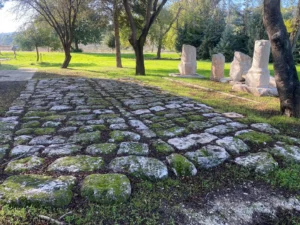Roman Roads Connected Gaza, Hebron, Jerusalem and Tiberias. What Is Left of Them Today?

Milestones and a Roman road at Givat Yeshayahu southwest of Jerusalem.Credit: Moshe Gilad
To my astonishment, an ancient path of white stones made its way among the weeds and grass. It looked only around 2 meters (6.6 feet) wide, but Tepper said that 2,000 years ago it was about 8 meters wide, perfect for two carts trundling side by side.
We walked along the path for a few dozen meters until it disappeared into a cultivated field. To our right, just 10 meters away, cars sped by on the road from Binyamina to Zichron Yaakov, well north of Tel Aviv.
There, across from the Shuni antiquities site, I felt as if a treasure had opened up in front of me. I never knew that this road existed. And as is often the case in Israel, even though the site seems to have enormous tourism potential, the place isn’t marked in any way.
Near Jerusalem we see such sites above the Sha’ar Hagai valley, and along Route 38 between Beit Shemesh and Beit Guvrin. In the north such places can be seen at the Megiddo and Golani junctions; actually, they’re at hundreds of spots throughout Israel. They’re the remains of the fabulous road network left here by the Romans. Two thousand years later, these arteries are still in excellent condition.
The empire’s engineers knew what they were doing. They used the straightest route possible, dodged natural obstacles, and left us with a moderate gradient passable in all seasons. The goal was to be able to travel about 30 kilometers (19 miles) a day with a load of about half a ton.
In the 1970s, Tel Aviv University professors Israel Roll (archaeology) and Benjamin Isaac (ancient history) surveyed the Roman roads here and produced a map of their finds. The map bears a striking resemblance to the layout of roads we use today, but now a great change is taking place: Israel’s new roads don’t follow the network that crisscrossed the country for two millennia.
